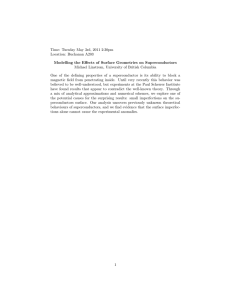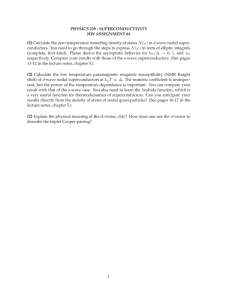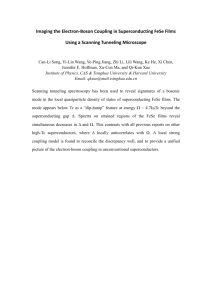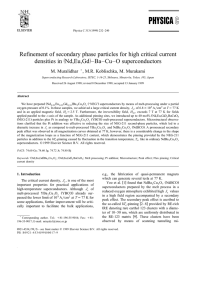T H. Kojo , S.I. Yoo , M. Murakami
advertisement
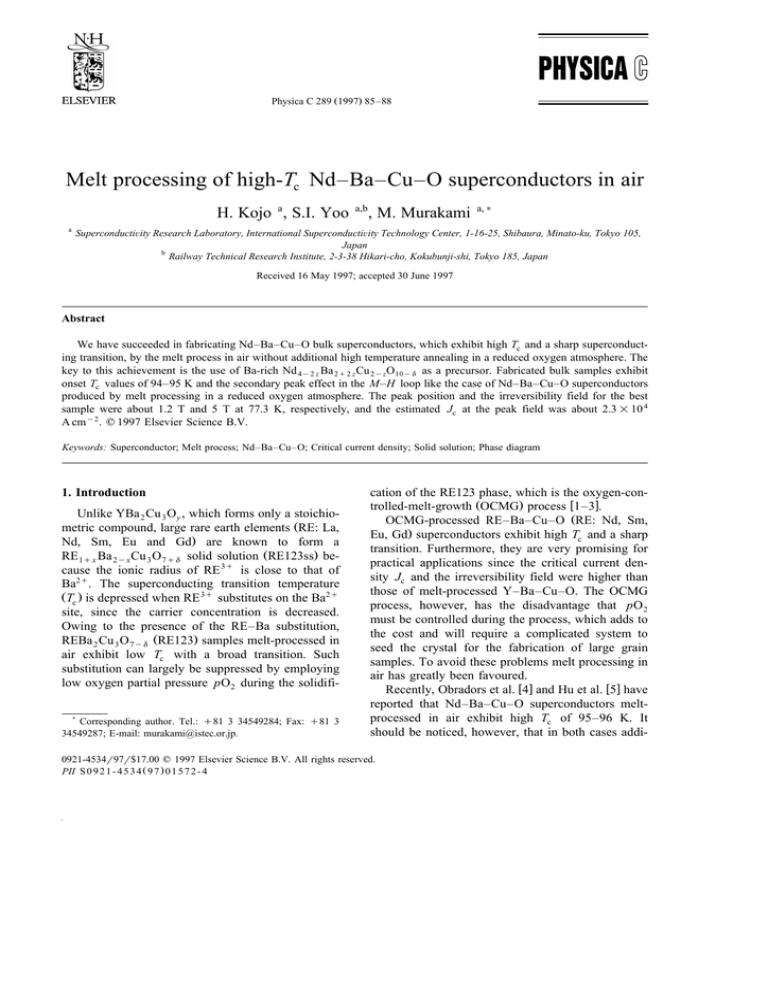
Physica C 289 Ž1997. 85–88 Melt processing of high-Tc Nd–Ba–Cu–O superconductors in air H. Kojo a , S.I. Yoo a a,b , M. Murakami a,) SuperconductiÕity Research Laboratory, International SuperconductiÕity Technology Center, 1-16-25, Shibaura, Minato-ku, Tokyo 105, Japan b Railway Technical Research Institute, 2-3-38 Hikari-cho, Kokubunji-shi, Tokyo 185, Japan Received 16 May 1997; accepted 30 June 1997 Abstract We have succeeded in fabricating Nd–Ba–Cu–O bulk superconductors, which exhibit high Tc and a sharp superconducting transition, by the melt process in air without additional high temperature annealing in a reduced oxygen atmosphere. The key to this achievement is the use of Ba-rich Nd 4y2 z Ba 2q2 z Cu 2yzO10y d as a precursor. Fabricated bulk samples exhibit onset Tc values of 94–95 K and the secondary peak effect in the M–H loop like the case of Nd–Ba–Cu–O superconductors produced by melt processing in a reduced oxygen atmosphere. The peak position and the irreversibility field for the best sample were about 1.2 T and 5 T at 77.3 K, respectively, and the estimated Jc at the peak field was about 2.3 = 10 4 A cmy2 . q 1997 Elsevier Science B.V. Keywords: Superconductor; Melt process; Nd–Ba–Cu–O; Critical current density; Solid solution; Phase diagram 1. Introduction Unlike YBa 2 Cu 3 O y , which forms only a stoichiometric compound, large rare earth elements ŽRE: La, Nd, Sm, Eu and Gd. are known to form a RE 1q x Ba 2yx Cu 3 O 7q d solid solution ŽRE123ss. because the ionic radius of RE 3q is close to that of Ba2q. The superconducting transition temperature ŽTc . is depressed when RE 3q substitutes on the Ba2q site, since the carrier concentration is decreased. Owing to the presence of the RE–Ba substitution, REBa 2 Cu 3 O 7y d ŽRE123. samples melt-processed in air exhibit low Tc with a broad transition. Such substitution can largely be suppressed by employing low oxygen partial pressure pO 2 during the solidifi) Corresponding author. Tel.: q81 3 34549284; Fax: q81 3 34549287; E-mail: murakami@istec.or.jp. cation of the RE123 phase, which is the oxygen-controlled-melt-growth ŽOCMG. process w1–3x. OCMG-processed RE–Ba–Cu–O ŽRE: Nd, Sm, Eu, Gd. superconductors exhibit high Tc and a sharp transition. Furthermore, they are very promising for practical applications since the critical current density Jc and the irreversibility field were higher than those of melt-processed Y–Ba–Cu–O. The OCMG process, however, has the disadvantage that pO 2 must be controlled during the process, which adds to the cost and will require a complicated system to seed the crystal for the fabrication of large grain samples. To avoid these problems melt processing in air has greatly been favoured. Recently, Obradors et al. w4x and Hu et al. w5x have reported that Nd–Ba–Cu–O superconductors meltprocessed in air exhibit high Tc of 95–96 K. It should be noticed, however, that in both cases addi- 0921-4534r97r$17.00 q 1997 Elsevier Science B.V. All rights reserved. PII S 0 9 2 1 - 4 5 3 4 Ž 9 7 . 0 1 5 7 2 - 4 H. Kojo et al.r Physica C 289 (1997) 85–88 86 tional Ar annealing at high temperatures above 9008C is indispensable to the achievement of high Tc . We suppose that during such treatment RE-rich phase with depressed Tc will decompose into Nd 4 Ba 2Cu 2 O 10 ŽNd422. plus the liquid phase, and then the phase with enhanced Tc solidifies from Nd422 and the liquid, leading to the recovery of high Tc . In the present paper, we show that Nd–Ba–Cu–O superconductors exhibiting Tc of 94–95 K and a sharp transition can be fabricated by the melt process in air without additional high temperature annealing in low pO 2 . 2. Experimental Four batches having different nominal compositions were prepared using precursors of NdBa 2Cu 3 O 7y d , Nd 0.9 Ba 2.1Cu 3 O 7y d , Nd 4 Ba 2 Cu 2 O 10 and Nd 3.6 Ba 2.4 Cu 1.8 O 10y d , which were independently prepared by the solid state reaction. Nominal compositions for the samples are shown in Table 1. Chemical compositions of the Nd422 and Nd 3.6 Ba 2.4Cu 1.8 O 10y d , which were analyzed by inductively coupled plasma ŽICP. spectrometry, are also displayed in the table. The results of powder X-ray diffraction ŽXRD. analyses for the precursor materials suggested that all the precursors were phase-pure at least on the X-ray level except Nd 0.9 Ba 2.1Cu 3 O 7y d which contained a small amount of BaCuO 2 phase. Although the solubility limit of Ba in Nd422ss was reported to be z s 0.1 y 0.15 w6,7x, an XRD pattern for Nd 3.6 Ba 2.4 Cu 1.8 O10y d indicates that a single phase is formed even when z s 0.2, suggesting that the solubility limit is higher than the reported values. Well-mixed precursor powders were uni-axially pressed into pellets of 20 mm diameter, and subjected to cold-isostatic pressing under a pressure of 200 kgrcm3. For the melt growth in air, the samples were placed on yttria-stabilized zirconia plates and ramped to 11208C in 3 h, held for 30 min, cooled to 10808C at a rate of 108Crmin, slowly cooled to 10108C at a rate of 18Crh, and then furnace cooled. Melt-grown samples were composed of many textured Nd–Ba–Cu–O grains of 5–10 mm diameter. Small samples with a rectangular cross section of 1.5 = 2.0 mm2 and 0.5–0.8 mm thickness were cut from textured domains, and then annealed in flowing pure O 2 gas at a rate of 300 mlrmin with the following temperature schedule: heated to 5008C in 3 h, held for 1 h, cooled to 3008C in 25 h, held for 200 h and finally furnace-cooled. DC magnetization measurements were performed with a Quantum design MPMS SQUID magnetometer. A zero-field-cooled warming procedure was used for the Tc measurement with the applied field of 10 Oe. The magnetization hysteresis loops were also obtained with the SQUID magnetometer for fields parallel to the c-axis. The Jc was estimated using the extended Bean model w8x. 3. Results and discussion Fig. 1 shows the temperature dependence of magnetization for the samples. The sample D, synthesized using stoichiometric Nd422 powder as the precursor, exhibits onset Tc of 90 K with a broad transition width of 10 K. In contrast, the samples A to C, synthesized using Ba-rich Nd422ss as the precursor, exhibit relatively high onset Tc values of 94–95 K with the transition width of 4–7 K. It is Table 1 Nominal compositions for batches A to D and chemical compositions of Nd 3.6 Ba 2.4 Cu 1.8 O10y d and Nd 4 Ba 2 Cu 2 O10 determined by ICP analyses Batch Nominal composition Nd:Ba:Cu ratio in Nd422 phase A B C D Nd 0.9 Ba 2.1Cu 3 O 7y d q 10 mol% Nd 3.6 Ba 2.4 Cu 1.8 O10y d Nd 0.9 Ba 2.1Cu 3 O 7y d q 20 mol% Nd 3.6 Ba 2.4 Cu 1.8 O10y d NdBa 2 Cu 3 O 7y d q 20 mol% Nd 3.6 Ba 2.4 Cu 1.8 O10y d NdBa 2 Cu 3 O 7y d q 20 mol% Nd 4 Ba 2 Cu 2 O10 Nd:Ba:Cus 3.66:2.39:1.75 Nd:Ba:Cus 3.66:2.39:1.75 Nd:Ba:Cus 3.66:2.39:1.75 Nd:Ba:Cus 4.00:2.04:1.96 H. Kojo et al.r Physica C 289 (1997) 85–88 Fig. 1. Temperature dependence of magnetic susceptibility for the batches A to D. The susceptibility was normalized with the value at 10 K. clear that the Tc and transition were greatly improved when the Ba-rich Nd422ss was used, although the transition is still broad compared to those of OCMG-processed Nd–Ba–Cu–O samples w2,3x. It should also be noted that even batch D shows muchimproved superconducting properties compared with the previous result w2,3x. It is probable that the formation of Nd-rich Nd123ss could be suppressed in the present experiment, since we used separately sintered Nd123 and Nd422 powders. The formation of high-Tc phase in air can be explained in terms of phase compatibility. The composition x of Nd 1q x Ba 2yx Cu 3 O 7q d , which is solidified through the peritectic reaction of Nd422ss and the liquid phase, is determined by the liquid phase composition which is compatible with the Nd 4y 2 z Ba 2q2 z Cu 2yzO 10y d at just above the peritectic temperature. As shown in Fig. 2, which is the schematic subsolidus NdO1.5 –BaO–CuO ternary phase diagram in air, the tie line of high-Tc Nd123 phase is connected to the Nd422ss, in which Ba content lies at the solubility limit. Therefore, the composition of the liquid phase which is compatible with high-Tc Nd123 phase should also be compatible with Ba-rich Nd422ss, although the exact number of z could not be determined in the present experiment. It is also probable that the presence of Ba-rich Nd422ss in the liquid will maintain Ba-rich liquid component, which also favours the formation of high-Tc Nd123 with suppressed Nd–Ba substitution. 87 We confirmed that Tc of 94–95 K could also be obtained using Nd 3.8 Ba 2.2 Cu 1.9 O 10y d instead of Nd 3.6 Ba 2.4 Cu 1.8 O 10y d , but the transition was broader. This suggests that the excess Ba in the solid solution of z s 0.1 is not sufficient to achieve the preferential formation of high-Tc phase. It might also be possible to simply prepare the Ba-rich liquid phase, however, for the melt-textured process, the reaction of the liquid phase with the substrate or the crucible will easily shift the liquid composition toward Ba-poor direction. It is thus concluded that the present success in growing high-Tc Nd123 phase in air is ascribed to the use of Ba-rich solid phase, that is, Ba-rich Nd422ss. Fig. 3 shows Jc –B curves of the samples A to D measured at 77.3 K for fields parallel to the c-axis. For comparison, the Jc –B curve of a Nd–Ba–Cu–O bulk with 20 mol% excess Nd422, which was OCMG-processed in 1% O 2 , is also displayed. While the absolute values of Jc for the samples A to C are still lower than that of OCMG-processed sample, they are much improved compared to the batch D. The peak effect, which is commonly observed in OCMG-processed RE123 superconductors is also observed in batches A to C, suggesting that the field-induced pinning center, which was first proposed by Murakami et al. w9x and later verified as the Fig. 2. Schematic subsolidus phase diagram of the NdO1.5 –BaO– CuO system in air. The range of the solid solution depends on the temperature and pO 2 and is approximate in this phase diagram. The tie lines are also schematic. Here it should be noted that Nd123ss has a solid solution towards the Nd-rich direction, while Nd422ss towards the Ba-rich direction, and high-Tc Nd123 with suppressed Nd–Ba substitution is compatible with Nd422ss in which the Ba content lies on the solubility limit. 88 H. Kojo et al.r Physica C 289 (1997) 85–88 Acknowledgements The authors would like to thank Toshima Co. Ltd for the preparation of sintered powders and DOWA Mining for compositional analysis with ICP. This work was partially supported by NEDO for the R & D Industrial Science and Technology Frontier Program. References Fig. 3. Magnetic field dependence of the critical current density Ž H 5 c and 77 K. for batches A to D and the Nd–Ba–Cu–O bulk OCMG-processed in 1% O 2 . clusters of Nd–Ba substituted phase with lower Tc finely dispersed in the Nd123 matrix w10–12x, also exists in the samples melt-processed in air. 4. Conclusions The utilization of Ba-rich Nd 4y 2 z-Ba 2q 2 zCu 2y zO10y d solid solution Ži.e. large z . as the precursor is the key to growing high-Tc phase of Nd 1q x Ba 2yx Cu 3 O 7q d solid solution with small x Ž0.0 - x - 0.1. in air, which implies that the fabrication process for Nd–Ba–Cu–O superconductors can be much simplified. Further improvement in both Tc and Jc is expected by the optimization of the processing conditions. w1x M. Murakami, S.I. Yoo, T. Higuchi, N. Sakai, J. Weltz, N. Koshizuka, S. Tanaka, Jpn. J. Appl. Phys. 33 Ž1994. L715. w2x S.I. Yoo, N. Sakai, H. Takaichi, T. Higuchi, M. Murakami, Appl. Phys. Lett. 65 Ž1994. 633. w3x S.I. Yoo, M. Murakami, N. Sakai, T. Higuchi, S. Tanaka, Jpn. J. Appl. Phys. 33 Ž1994. L1000. w4x X. Obradors, R. Yu, B. Martinez, F. Sandiumenge, N. Vilalta, V. Gomis, S. Pinol, Proceeding of International Workshop on Critical Currents in Superconductors for Practical Applications, Xian, 1997, submitted for publication. w5x A.M. Hu, S. Jia, H. Chen, Z.X. Zhao, Physica C 272 Ž1996. 297. w6x W. Wong-Ng, B. Parentzkin, E.R. Fueller Jr., J. Solid State Chem. 85 Ž1990. 117. w7x P. Karen, O. Braaten, A. Kjekshus, Acta Chem. Scand. 52 Ž1992. 805. w8x E.M. Gyorgy, R.B. van Dover, K.A. Jackson, L.F. Schneemeyer, J. Waszcazk, Appl. Phys. Lett. 55 Ž1989. 283. w9x M. Murakami, S.I. Yoo, T. Higuchi, N. Sakai, M. Watabiki, N. Koshizuka, S. Tanaka, Physica C 235–240 Ž1994. 2781. w10x T. Egi, J.G. Wen, K. Kuroda, H. Unoki, N. Koshizuka, Appl. Phys. Lett. 67 Ž1995. 2406. w11x W. Ting, T. Egi, R. Itti, K. Kuroda, N. Koshizuka, Adv. Superconduct. 8 Ž1996. 481. w12x H. Kojo, S.I. Yoo, N. Sakai, M. Murakami, Superlattice Microstruct. 21 Ž1997. 83.
